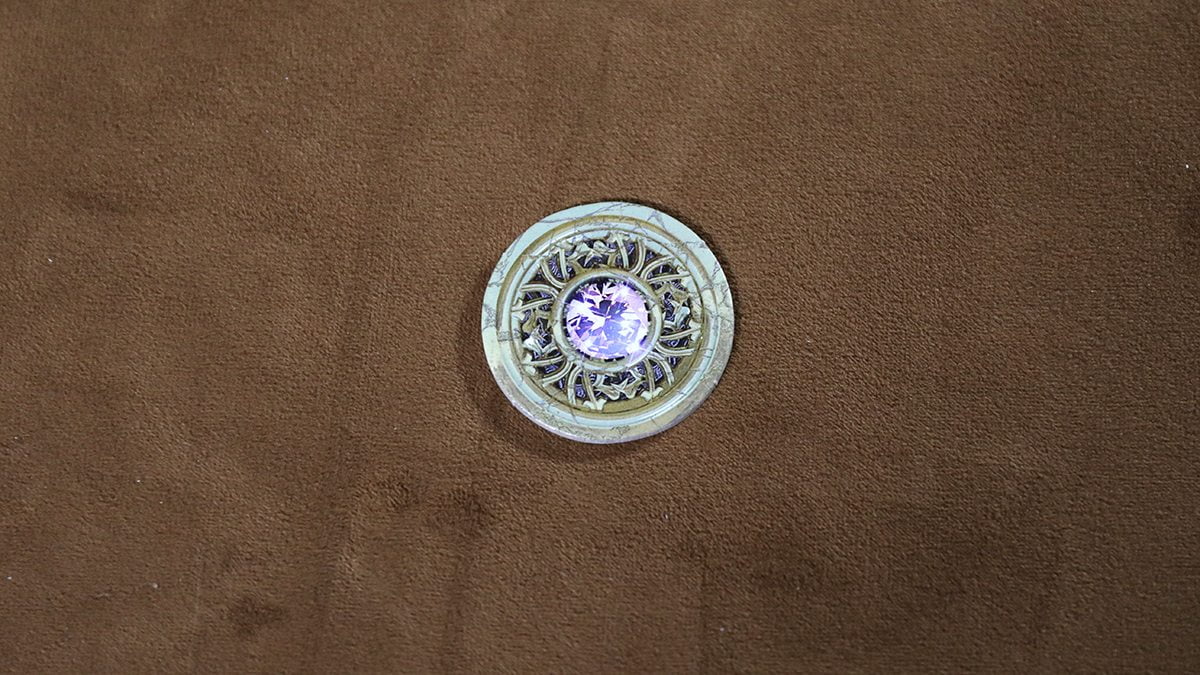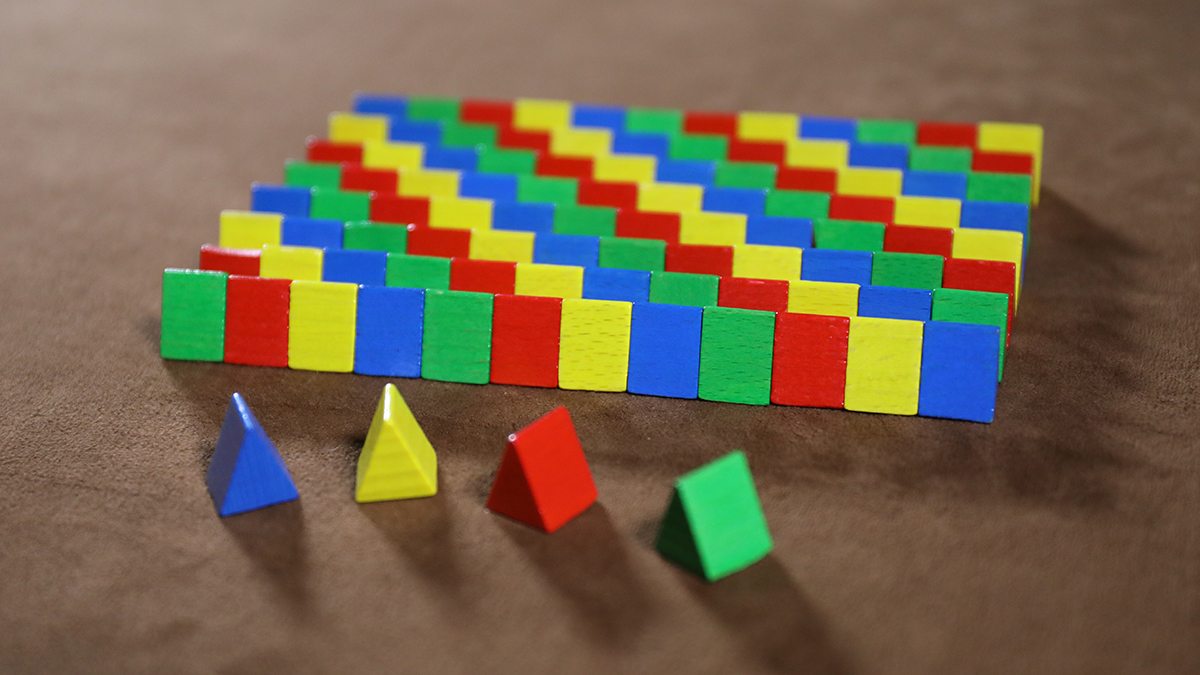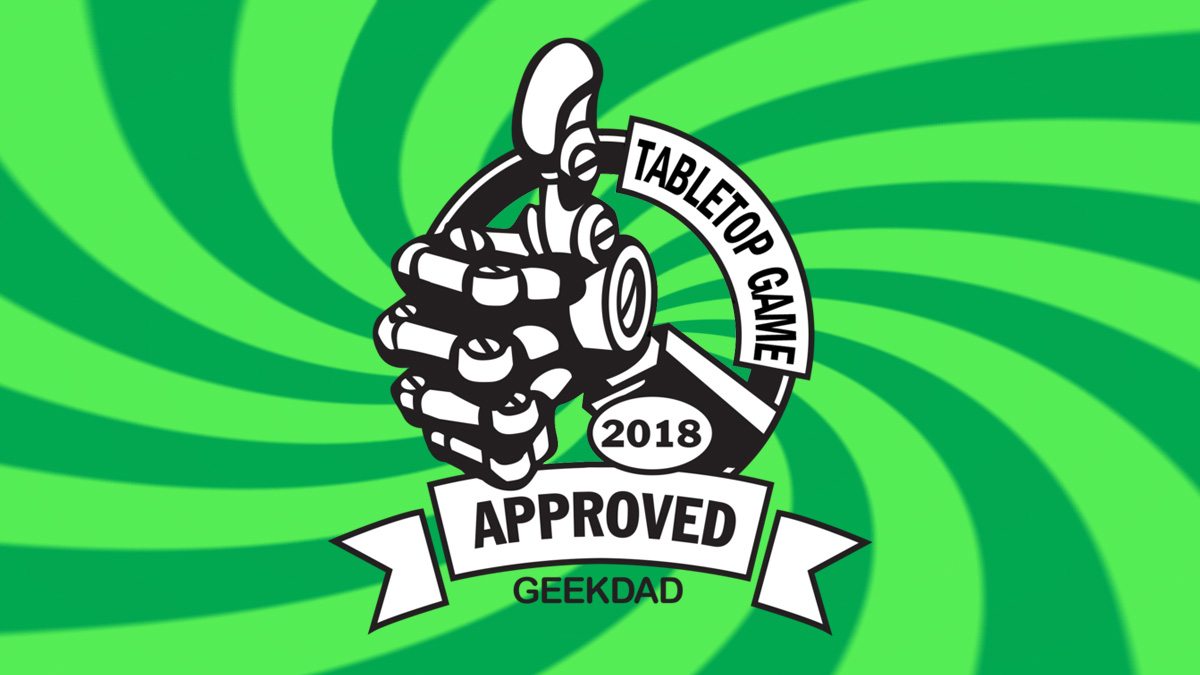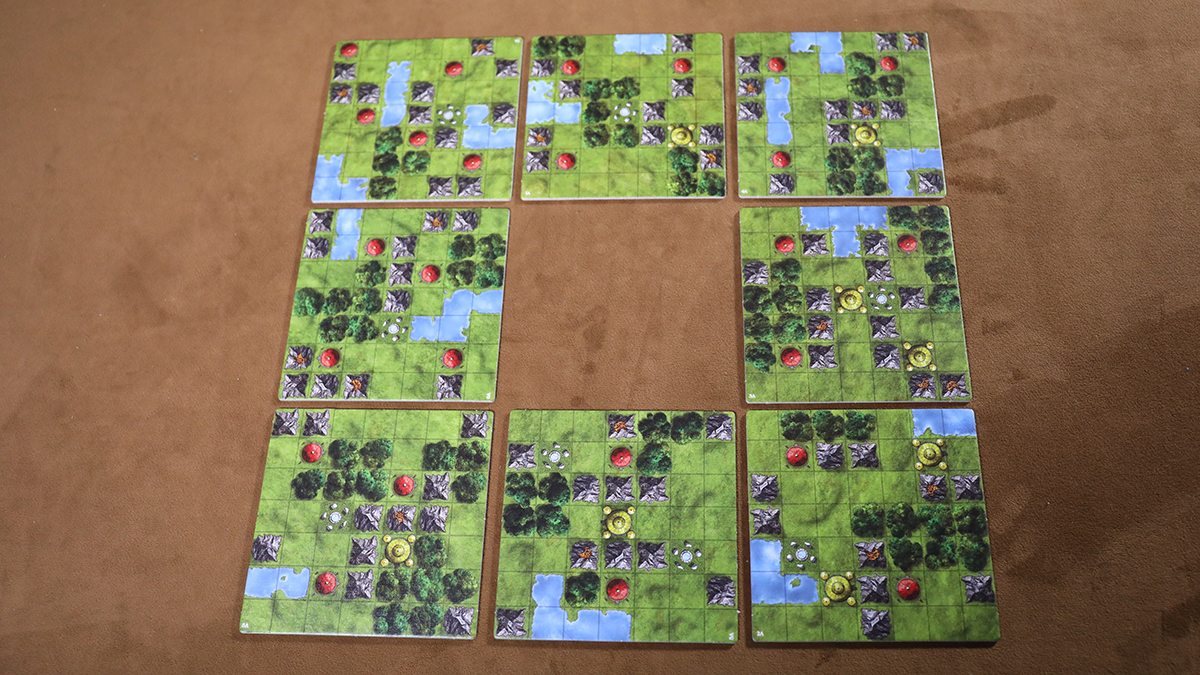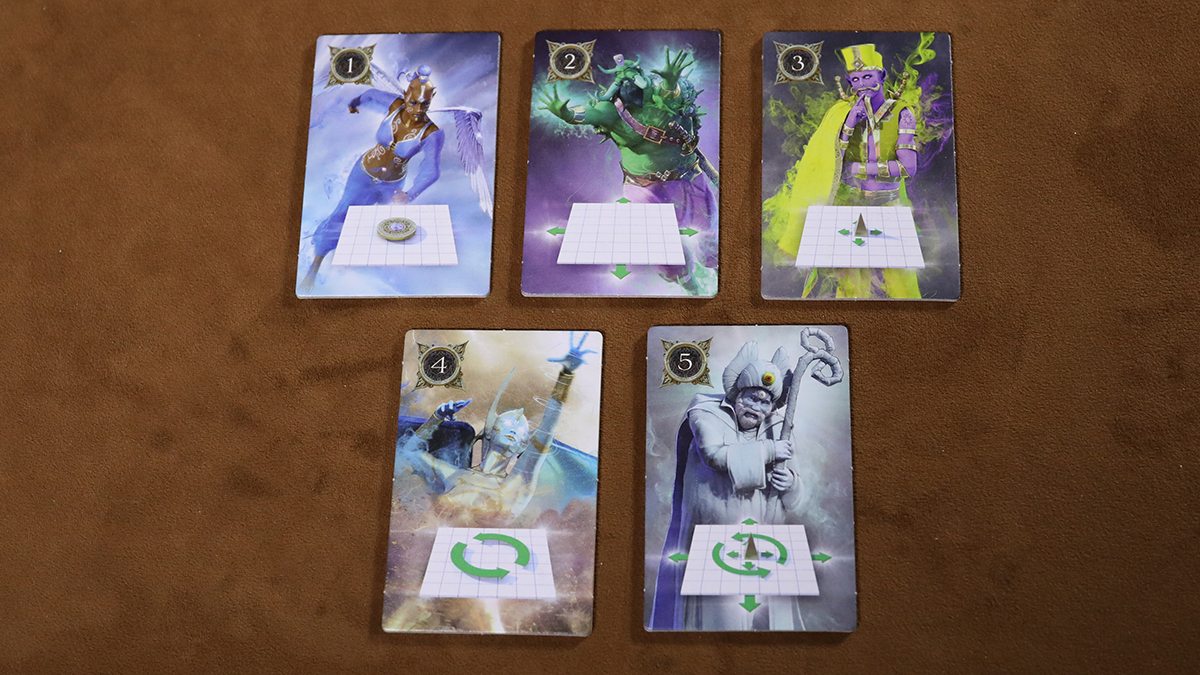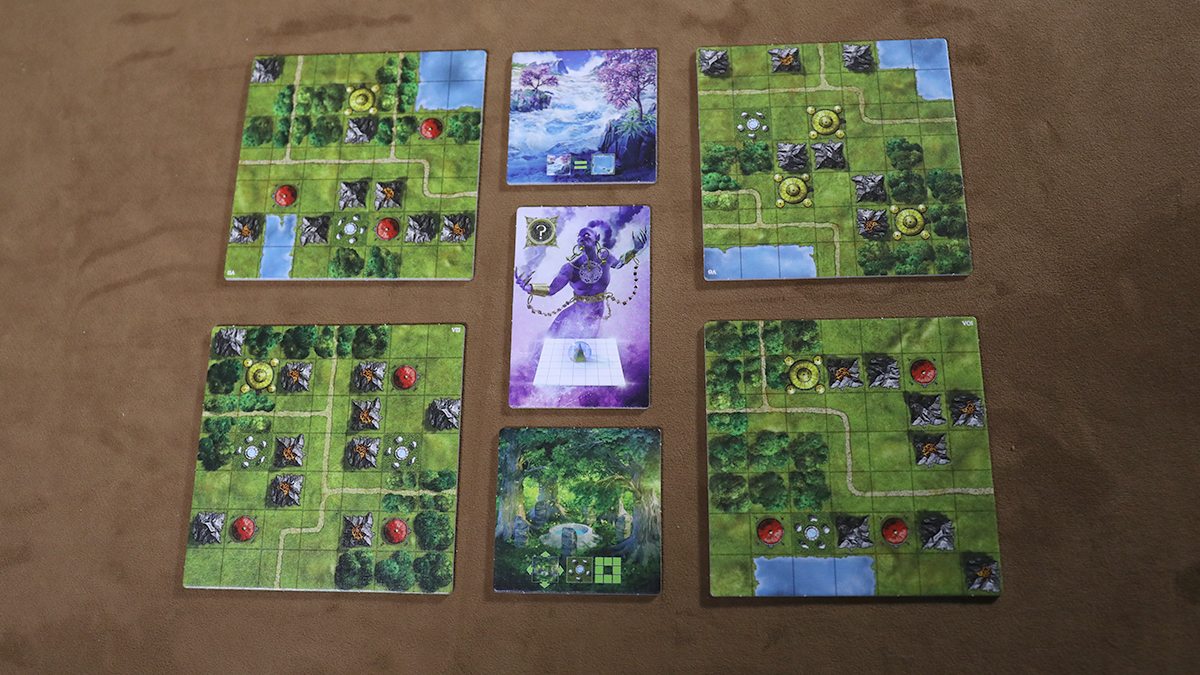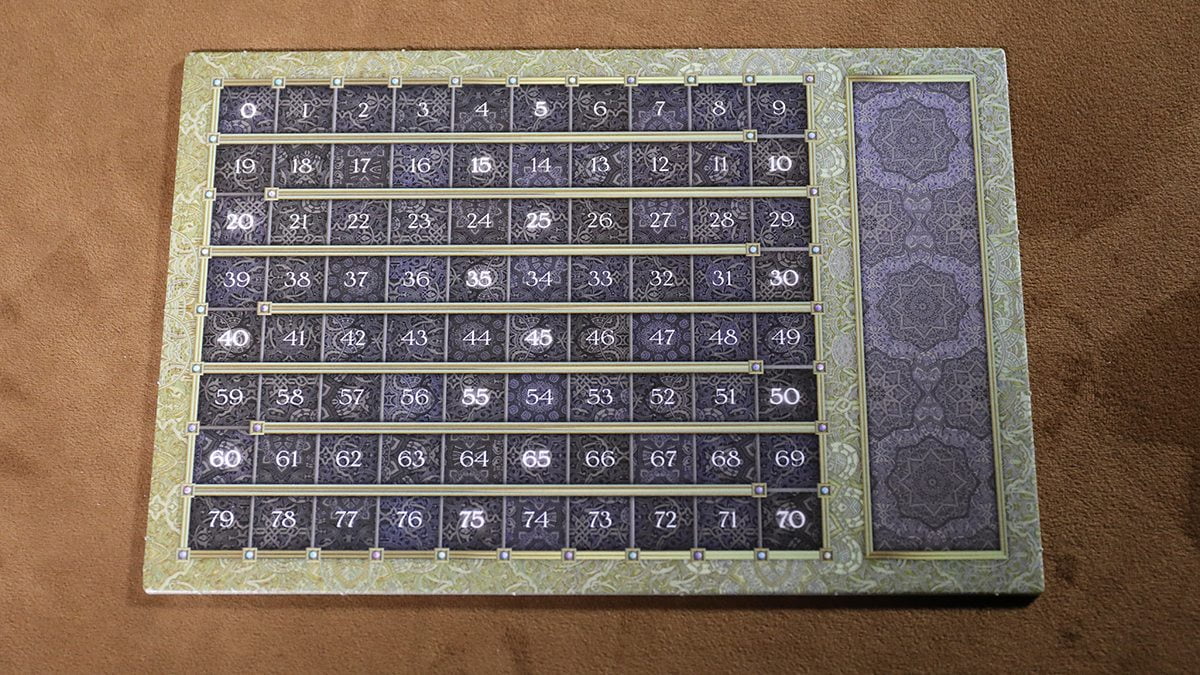The island of Dokmus has been found, our tribal homeland and birthplace of our god, Dokmus. each player is a mighty warrior in this abstract strategy game for 2-4 players, aged 10 and up, which plays in about half an hour. You are all working to earn the favor of Dokmus, who is only impressed by victory points! Dokmus is a very clever abstract area control game that will have you scratching your head and wanting to play over and over. Dokmus, which had limited run two years ago, launches in wide release next week alongside an expansion.
Dokmus Components
Do you hear that? It sounds a lot like polite applause. That’s because even though there is a modest number of components in Dokmus, the box isn’t four times the size that’s needed to hold them. The box is about the size of what you’d expect from a big box game, but its depth is very shallow. That means it’s easy to see on the game store shelf, but easy to tuck away at home. What’s more, the expansion, box and all, fits inside this slim core box, along with all the core components. It’s elegant. Bravo! Take notes, everyone else!
Inside the nicely sized box, you’ll find:
- 8 Double-sided map tiles
- 5 Guardian cards
- 1 Talisman marker (to note the first player)
- 1 Victory point scoreboard
- 4 Scoring cubes (1 each, in 4 colors)
- 100 Tokens (25 each, in 4 colors)
- 6 Quick reference guides
The map tiles are squares on good cardboard. The art on them is a top-down landscape from which you can see forests, meadows, rivers, mountains, volcanoes, temples, and ruins. The Talisman is a big, circular cardboard medallion. It has intricate goldwork and a many-faceted jewel in its center. The Guardian cards are not just cards, but thick cardboard. Their backs are identical, but on the business side, each has a different guardian, art depicting the guardian’s ability, and a number noting its place in the turn order. The scoring track is the largest piece of cardboard and has a snaking track of numbers from 0 to 79. It also has a partition to create a receptacle that is used during gameplay.
The score cubes are cubes. Woohoo! They are only used at the end of the game. The 25 tokens that each player gets are all identical except for color. They are triangles with steep sides and I think they are meant to represent tents or encampments as you explore the island. The rule book doesn’t really say and it’s an abstract game, but that’s how we referred to them.
Dokmus is GeekDad Approved!
How do you play Dokmus ?
Setup
The eight map tiles should be shuffled and then placed in a 3 x 3 grid with the center space left open. The score track is set to the side of the playing area, along with the scoring cubes. Each player gets 25 tokens in a single color of their choosing. One player is randomly given the talisman to be the first player. That player is also given all of the guardian cards.
Each player must find a starting position on the border. This must be on the outside edge of one of the four corner maps. No more than one player can begin on the same map tile and each player’s initial token must be placed on either a meadow or forest space. Gameplay is ready to begin.
Gameplay
Play takes part in three phases. First, beginning with the first player, players privately select a guardian card to help them out in the coming turn. Any remaining cards are set aside, face-down so no one can predict who has which card.
Next, players take turns in the order of the guardian cards they have chosen. Someone at the table should ask who has the #1 card. That player then reveals their card and takes their turn, utilizing their guardian power in the process. If no one has a certain number, the call for cards should just advance.
On a player’s turn, they get to use three tokens on each turn, according to a number of rules. If they cannot place their tokens or if they choose, they may simply sacrifice a token as well. When placed on the map, each token must be orthogonally adjacent to another of that player’s color. There are seven types of terrain on the maps and how tokens interact with the terrain is unique for each type.
- Meadows — No effect.
- Mountains — A player cannot place a token on a mountain.
- Volcano — A player can place on a volcano as a means of getting to terrain beyond the volcano. However, at the end of that player’s turn, the token is removed from the volcano and placed on the partitioned side of the scoring board that holds sacrificed tokens.
- Temple — A player may not place a token on a temple, large or small. Temples act as connectors, which allow players to pass through them to use adjacent terrain spaces. That is, if a player is located at the south end of a temple with a temple one space north of them, they may legally place at the temple’s east, north or west location.
- Forest — Forests are difficult to navigate, so they require a sacrifice of one token upon entering. A player does not have to sacrifice if they are already in the forest on an adjacent forest space, if they are traveling to a temple-adjacent space that does not involve crossing other terrain to reach the next forest space, if they move from forest space to forest space using a waterway, or the player uses the guardian “move a token” action.
- Water — Players may not place a token on a water terrain, but they may use the waterway to travel. To do this, a player must sacrifice a token on entering the water and may place the next token anywhere along the waterway, according to all of the rules governing terrain, with the exception on the forest rule (players need not sacrifice another token to enter a forest when exiting a waterway). This applies to water that contiguously crosses multiple tiles as well. Further, if a player exits via a temple terrain, they may place in a terrain adjacent to the temple, according to the temple rules.
- Ruins — When a player places a token on the ruins terrain, they may perform an additional guardian action of the player’s choosing.
It is up to the players how to play their turns. They may place tokens and take their guardian action in any order they choose. There are five guardian actions to choose from:
- Inahuj, guardian #1 — This guardian grants the ability to move first in the turn order.
- Hogel, guardian #2 — With this guardian, the player may move a map tile. Tiles must move in a straight line, horizontally or vertically and must remain within the confines of the 3×3 grid. When moving this way, a player may choose to have a tile “jump” over a tile, so, for example, the top right tile could move to the bottom right spot on the grid.
- Paryon, guardian #3 — This power enables a player to move an existing token placement on a meadow, forest, or volcano to an adjacent and empty meadow, forest, volcano, or ruin terrain. Paryon doesn’t give the power to cross water though.
- Mihayla, guardian #4 — Mihayla is a powerful entity, granting the player the ability to rotate any map tile 90º clockwise or anti-clockwise.
- Zarul, guardian #5 — Zarul, however, is the most powerful of all. This ancient guardian allows the player to choose from the powers of Hogel, Paryon, or Mihayla and use one of their abilities for themselves.
For the third and final, cleanup phase, players gather the guardian cards, give them to the current player with the talisman and begin again.
The game lasts eight rounds, with players putting out three tokens. When all tokens have been placed, the game moves to scoring. Every token on a ruin scores 1 vp. For temples, a token placed adjacent to a small temple earns 2 vp and a token adjacent to a large temple scores 3 vp. If any player has discovered all temples on any single map tile (by placing a token adjacent to the temples), they earn 8 vp (just 5 vp in a two-player game).
The final two means of scoring involve tables. One table delivers points for the number of tiles where a player has discovered at least one temple. Points range from a single point for one tile up to 27 points for all eight tiles. Lastly, the sacrificed tokens are tallied and points are given, depending on the number of players. Last place never gets any points. Most points wins!
An Expansion Releases the Same Day as the Core Game
The same day the core box hits stores, an expansion accompanies Dokmus. This is likely because Dokmus is really a re-release, having been published in limited quantities in 2016. Return of Erefel adds all kinds of goodies to an already stout base game. There are four more double-sided maps, 2 double-sided scenario tiles, and a new guardian card.
The maps introduce a new terrain, roads, which traverse meadows and forests. Roads allow a player who would be placing a token on the road space to place it one space further. Additionally, a forest space with a road does not require the usual sacrifice. The guardian, Erefel, who is automatically the highest number among unchosen guardians each round. Erefel allows players to enter forests or waterways without having to sacrifice a token.
The scenario tiles are optional but if you choose to use one, place it in the empty center spot at setup and move it with the empty space as tiles get moved around the board. The scenarios are: ice, winds, water, and sun.
In the ice scenario, all waterways are frozen and no longer require a sacrifice to enter them. Players slide directly across the water, orthogonally. In winds, if a player were to place on a road, they can place two further instead of the usual one. If a player were to place in a meadow, they may place one further as well. In water, the scenario tile acts as a waterway, connecting all tiles adjacent to it and connecting waterways on the edges of those tiles. Normal waterway rules apply. Finally, in sun, when a player places a token on a ruins terrain on a tile that is orthogonally adjacent to this scenario tile, they may use their extra guardian action on any map tile.
In a stroke of luck or brilliance, you can fit the entire expansion, box in all, in the already slim core box. It’s fantastic and exactly what my collector’s brain needs to feel happy about this game and its expansion.
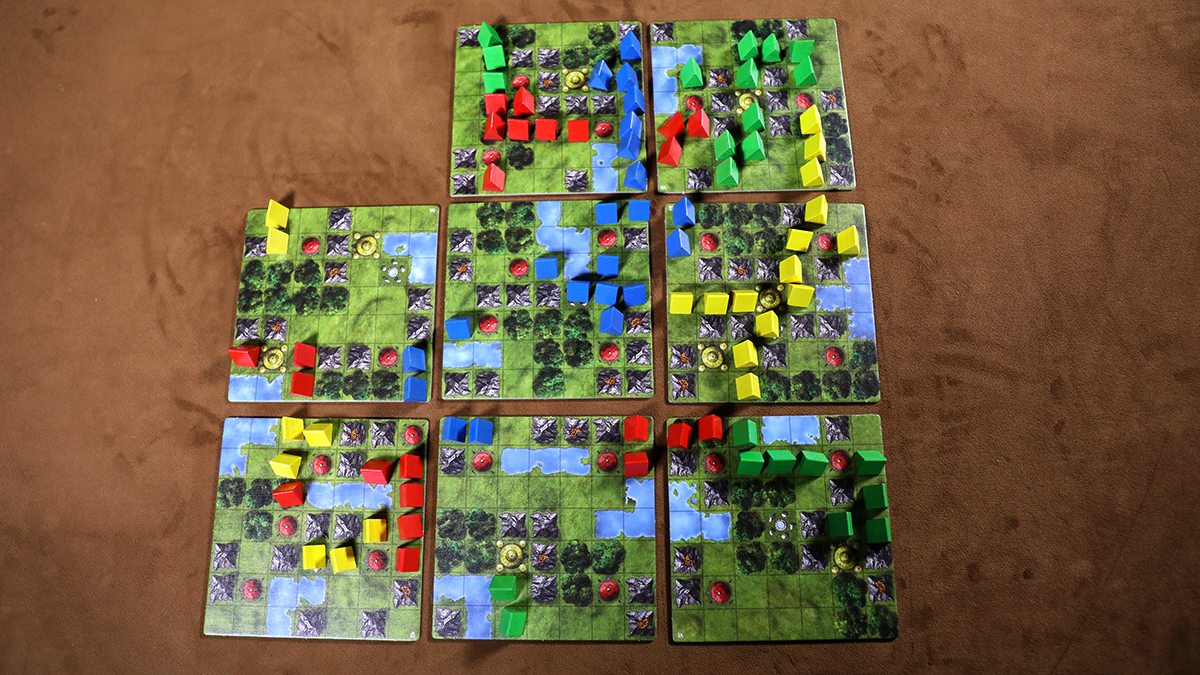
Why You Should Play Dokmus
Abstract strategy games are among my favorite because most live in a world of almost no luck. They are truly gamer’s games and Dokmus is representative. Moving tiles and placing tokens becomes a very thinky exercise as you try to figure out how to reshape the island to the benefit of your victory points.
The only element of gameplay that you can’t control is the turn order and it’s very possible for the person who starts the game with the talisman to always go first for the rest of the game. There’s not much advantage to this for that player because the talisman doesn’t carry any other game powers. So it’s a negligible complaint.
You can develop a plan for what you want to do on your turn and choose the guardian you think will help you, but that strategy may very well be derailed when the player before you moves or rotates a tile and dashes your plans. So Dokmus requires you to think quickly on your feet. Thankfully, there are lots of ways to score points, and because you can add tokens from any of your existing tokens, there’s always someplace to play.
When you sit down, you may think the game is going to take a long time because of all the tokens each player has, but that’s erroneous. Since players all play three tokens on every turn, the game flies by pretty quickly in just eight fast rounds, especially for an abstract game. Sure, you may end up with someone who has a tough time with strategy games and slows things down, but if everyone is on board, the experience flashes by and, next thing you know, you’re resetting for another game.
And each game is a real treat. The goals are simple and known, just score victory points. But getting there presents a unique enterprise that will have you thinking very hard about what amounts to a puzzle in front of you. If you know you wish to discover temples on as many tiles as possible, how do you move your tokens and the tiles to get there? And when another player moves your tile (and all your tokens) further away, what do you do next? The strategy can be a bit chaotic at times, as the island moves and spins like a cardboard version of the city in Inception, but it’s a creative challenge and a great brain teaser.
Dokmus is a game that’s had a lot of buzz since it first came out a couple of years ago, and now that it has wide distribution, it’s one that I’m hoping gets more attention because it’s easy to teach, easy to play, and a really great gaming experience. It’s a game that you play and immediately want to replay, and then you move on to another game and you’re still thinking about Dokmus, and for that reason, we consider it GeekDad Approved.
Dokmus releases next week along with Return of Erefel. The core game is available for $40.00 and the expansion retails for $25.00.
Click here to see all our tabletop game reviews.
If you’d like to stay up-to-date with all of our tabletop gaming coverage, please copy this link and add it to your RSS reader.
Disclosure: GeekDad received a copy of this game for review purposes.

